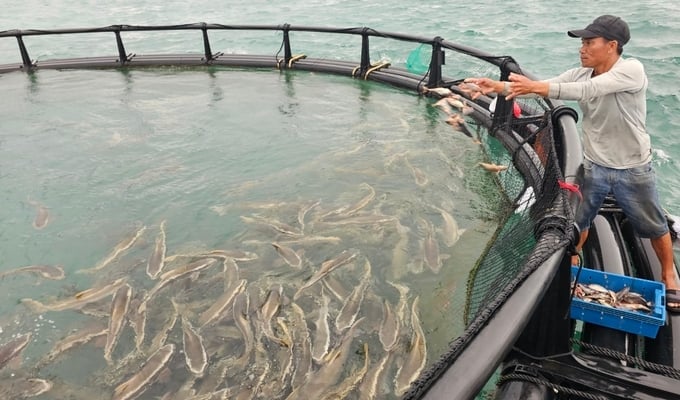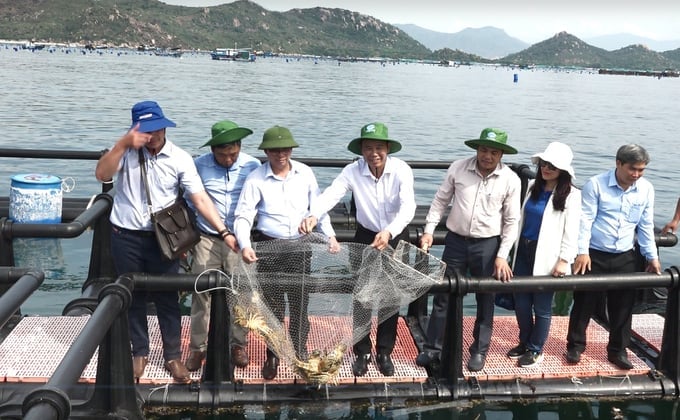June 21, 2025 | 19:03 GMT +7
June 21, 2025 | 19:03 GMT +7
Hotline: 0913.378.918
June 21, 2025 | 19:03 GMT +7
Hotline: 0913.378.918

A delegation from the Ministry of Agriculture and Rural Development (MARD) and Khanh Hoa Provincial People's Committee visiting a high-tech mariculture model in Cam Lap commune, Cam Ranh city. Photo: KS.
Rapid growth and lower disease risks
Khanh Hoa Provincial People's Committee, in collaboration with Thien Tam Fund (Vingroup Corporation), organized a closing ceremony on June 7 for the pilot high-tech mariculture model in Cam Lap commune, Cam Ranh city.
The event saw the participation of Deputy Minister of Agriculture and Rural Development Phung Duc Tien, Chairman of Khanh Hoa Provincial People's Committee Nguyen Tan Tuan, and representatives from departments, committees, and relevant agencies in Khanh Hoa province.
Khanh Hoa province launched an initiative for high-tech open water mariculture in May 2023. The initiative aims to demonstrate the contents of the Politburo’s Resolution No. 09 and the Government’s Resolution No. 42; namely, the construction and development of Khanh Hoa province until 2030, with a vision towards 2045. These Resolutions emphasize a "strong development of the maritime economy, with a focus on aquaculture, harvesting, seafood processing, particularly high-tech mariculture, and environmentally friendly practices."
With the sponsorship of Thien Tam Fund, Khanh Hoa province’s Department of Agriculture and Rural Development collaborated with the Research Institute for Aquaculture III (Ministry of Agriculture and Rural Development) to develop a pilot project for high-tech mariculture in Khanh Hoa province.
After receiving approval from the Prime Minister and the Provincial People's Committee, Khanh Hoa province’s Department of Agriculture and Rural Development instructed the local Agricultural Extension Center to collaborate with Thien Tam Fund and suppliers to install mariculture cages, surveillance cameras, and positioning devices for farmers before releasing shrimp and fish fry into the supported cages.
According to Khanh Hoa province’s Department of Agriculture and Rural Development, the pilot project selected ten qualified households for participation, and provided them with 16 round HDPE cages, with a size of 800 cubic meters per cage, for mariculture; and 12 two-tiered square HDPE cages, with a size of 24 cubic meters per cage, for lobster farming.

Nguyen Van Cu, a resident from Cam Lap commune, Cam Ranh city, stated that aquatic species farmed in open sea waters benefits from faster growth thanks to the clean water source. Photo: KS.
Following the closing ceremony on the morning of June 7, Deputy Minister Phung Duc Tien and the delegation traveled by boat to visit the open water mariculture models managed by Phan Van Thanh and Nguyen Van Cu from Cam Lap commune, Cam Ranh city. Phan Van Tho is currently farming green lobsters with an HDPE raft system that comprises a cluster of 6 cages, each with a volume of 24 cubic meters, arranged in two tiers for a total of 12 cages.
During the visit, members of the delegation commended the households for their effective and successful open water mariculture models. According to the model owners, the clean water source in open water areas facilitates rapid growth of the farmed aquatic species, with lower mortality rates and reduced disease risks compared to near-shore aquaculture.
Nguyen Van Cu shared that he previously farmed cobia in traditional wooden cages, requiring up to ten months for the fish to reach an individual weight of between five and eight kilograms. Subsequently, the use of larger and more spacious HDPE cages allowed the fish to reach the same weight in 7.5 to 8 months.
Furthermore, the sturdy and environmentally friendly cages are shielded against severe weather conditions; thereby preventing farmers from suffering heavy losses.
Plans to expand high-tech mariculture models
According to Khanh Hoa province’s Department of Agriculture and Rural Development, after one year of implementation, the HDPE cages in the pilot high-tech mariculture model have yielded higher profits compared to traditional wooden cage farming models. Notably, the cobia farming model achieved an average profit margin of 172%, the lobster farming model 112%, and the grouper farming model 131%.
Chairman Nguyen Tan Tuan expressed his delight at the initial results of the local high-tech mariculture model. He noted that the model promotes sustainable environmental practices in the aquaculture process. Moreover, it conserves water surface area and enables fishermen to effectively manage their farming areas using advanced technologies and techniques.

Deputy Minister Phung Duc Tien (center) visiting a lobster farming model in HDPE cages. Photo: KS.
Chairman Tuan believes that the initial success of the project will serve as a foundation for promoting and expanding high-tech mariculture models throughout the province in the near future.
Accordingly, Khanh Hoa province will report to the Government for the Prime Minister's early approval of the project. On the other hand, the province will continue researching and enacting specific policies to support the local fishing community.
Notably, the Provincial People's Council will study regulations to support initial capital and interest subsidies for fishermen transitioning from traditional wooden cages to HDPE cages with the aim of protecting their assets, and adapting to natural disasters.
The province will establish insurance support policies for fishermen engaged in open water mariculture and accident insurance for fishermen engaged in fishing and mariculture activities at sea. This approach aims to integrate the exploitation of marine resources with the protection of maritime security and sovereignty. Additionally, this policy complies with the government and the Prime Minister's priorities in implementing the Politburo's Resolution No. 09 in Khanh Hoa province.
According to Deputy Minister Phung Duc Tien, Khanh Hoa province possesses significant potential for mariculture. Namely, Khanh Hoa has been a pioneering province in implementing high-tech mariculture in collaboration with Vingroup Corporation. Both parties have successfully constructed, supported, and manufactured HDPE cages similar to those in Norway.
According to reports, the effectiveness of cobia, lobster, and grouper farming in high-tech mariculture models with HDPE cages has remained at a consistently high level. Consequently, the model will be expanded within Khanh Hoa and 27 other coastal provinces and cities to utilize the local potential for mariculture and maritime economy; thereby reducing exploitation activities to promptly remove the EC's "yellow card".
Translated by Nguyen Hai Long
![Turning wind and rain into action: [9] Digitizing hydrometeorological data in response to climate change](https://t.ex-cdn.com/nongnghiepmoitruong.vn/608w/files/news/2025/06/17/z6704423696987_15fd32ffc26d590d204d520c9dac6786-nongnghiep-165943.jpg)
(VAN) Farmers have begun accessing hydrometeorological applications to adjust their cropping schedules, aiming to ensure productivity and adapt to climate change.
![Turning wind and rain into action: [8] Real-time salinity detection and early warning technology](https://t.ex-cdn.com/nongnghiepmoitruong.vn/608w/files/news/2025/06/17/z6704423696987_15fd32ffc26d590d204d520c9dac6786-nongnghiep-151127.jpg)
(VAN) Thanks to the integration of modern hydrological-hydraulic models, remote sensing technologies, and artificial intelligence, the accuracy of hydrological forecasting has significantly improved.
![Turning wind and rain into action: [7] Early disaster warnings help marine farmers minimize losses](https://t.ex-cdn.com/nongnghiepmoitruong.vn/608w/files/news/2025/06/17/z6704423696987_15fd32ffc26d590d204d520c9dac6786-nongnghiep-142942.jpg)
(VAN) In recent years, thanks to early disaster warnings and forecasting, marine farmers in Khanh Hoa province have been able to reduce risks and losses, thereby improving production efficiency.
![Turning wind and rain into action: [6] ‘Four on-the-spot’ disaster management software](https://t.ex-cdn.com/nongnghiepmoitruong.vn/608w/files/news/2025/06/17/e5a48259d6a262fc3bb3-nongnghiep-183800.jpg)
(VAN) By simply activating the scenario on the disaster management software, the relevant authorities immediately know how many households need to be evacuated, where to evacuate them to, and by what means of transportation…
![Turning wind and rain into action: [5] Hue applies modern technology in disaster forecasting](https://t.ex-cdn.com/nongnghiepmoitruong.vn/608w/files/news/2025/06/17/z6704423696987_15fd32ffc26d590d204d520c9dac6786-nongnghiep-093938.jpg)
(VAN) In Hue city, modern technology has recently been applied in meteorological and hydrological forecasting and warning, helping to reduce the damage caused by natural disasters.

(VAN) A cutting-edge farming technique being implemented on an experimental ranch in Arizona's Sonoran Desert has already saved a billion gallons of water over five years, according to Civil Eats.

(VAN) Poultry and pig production and the environment can be boosted through enhanced water technology, according to new research.